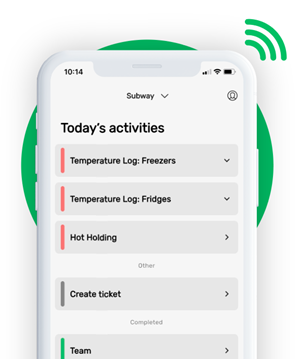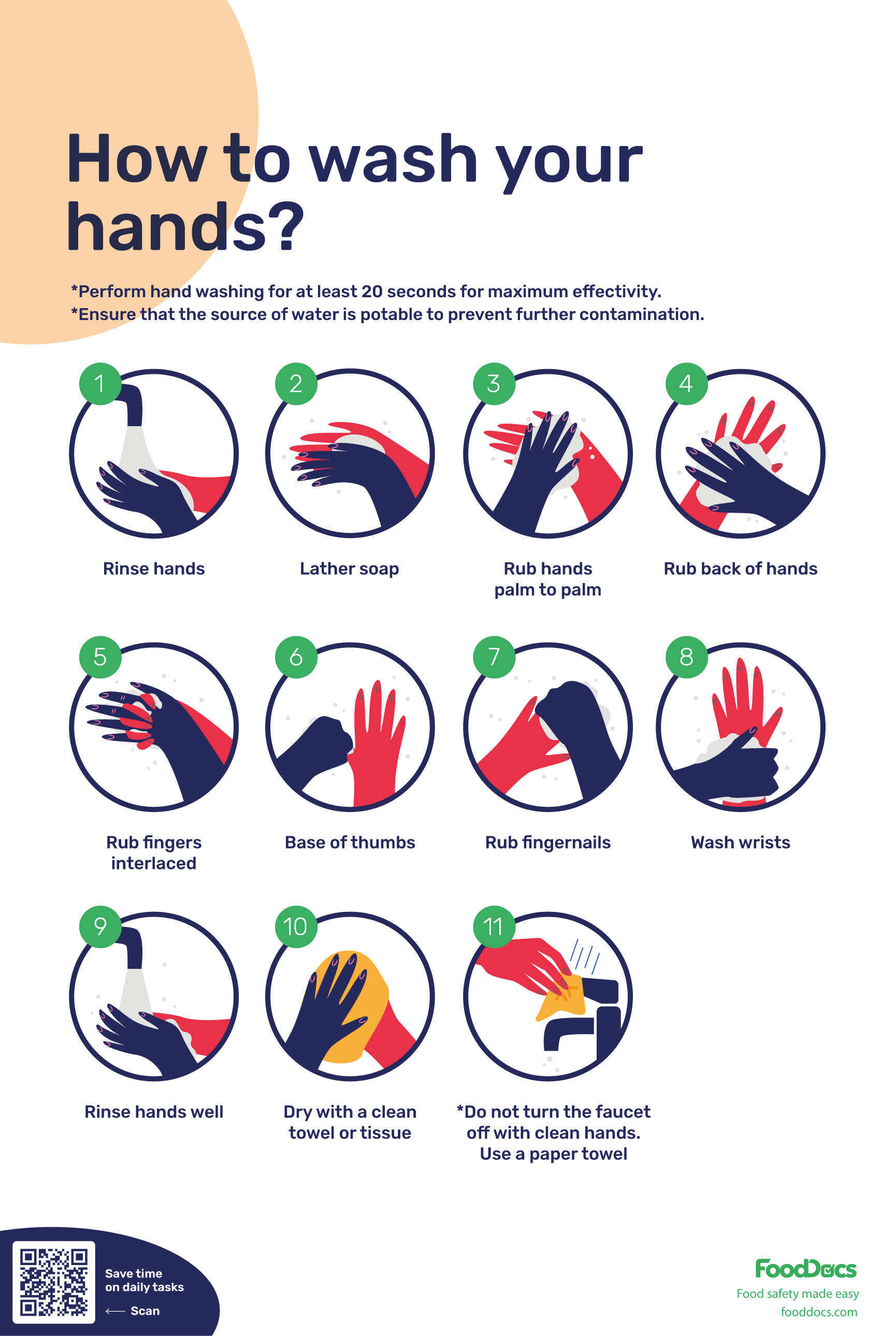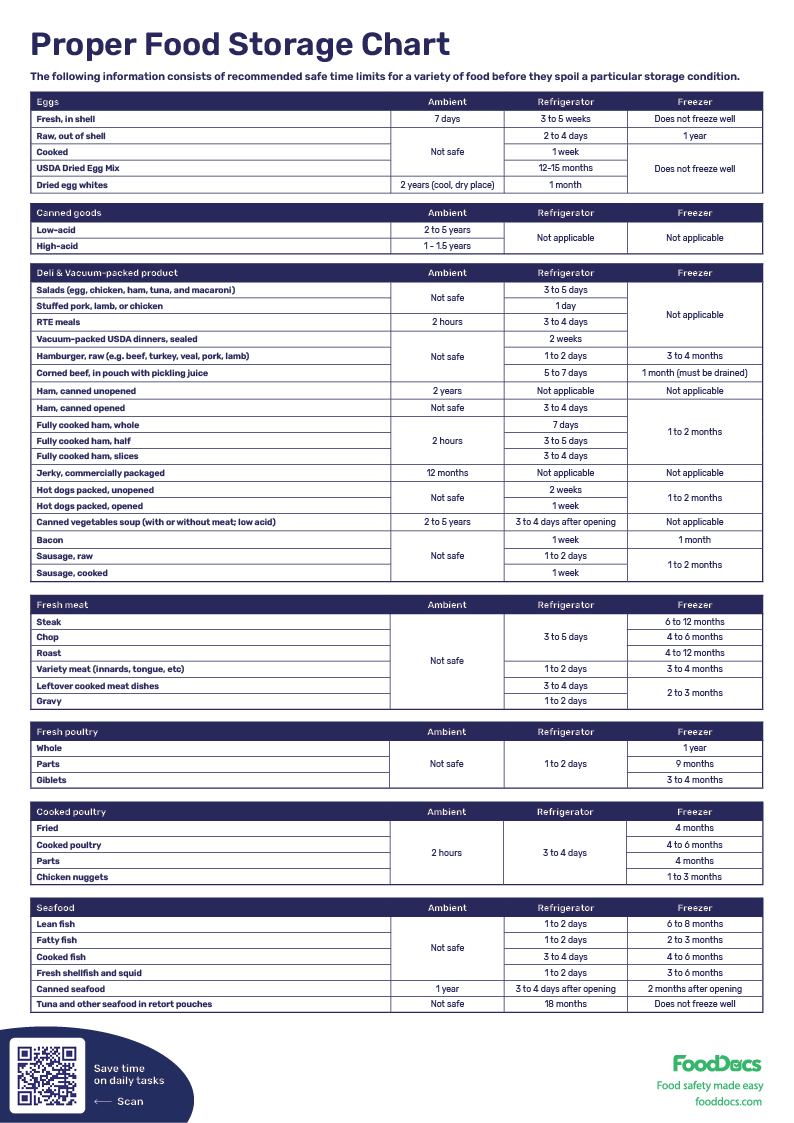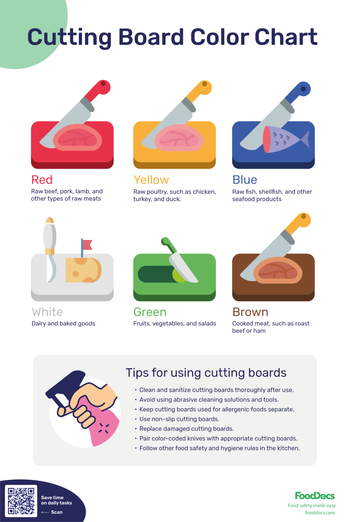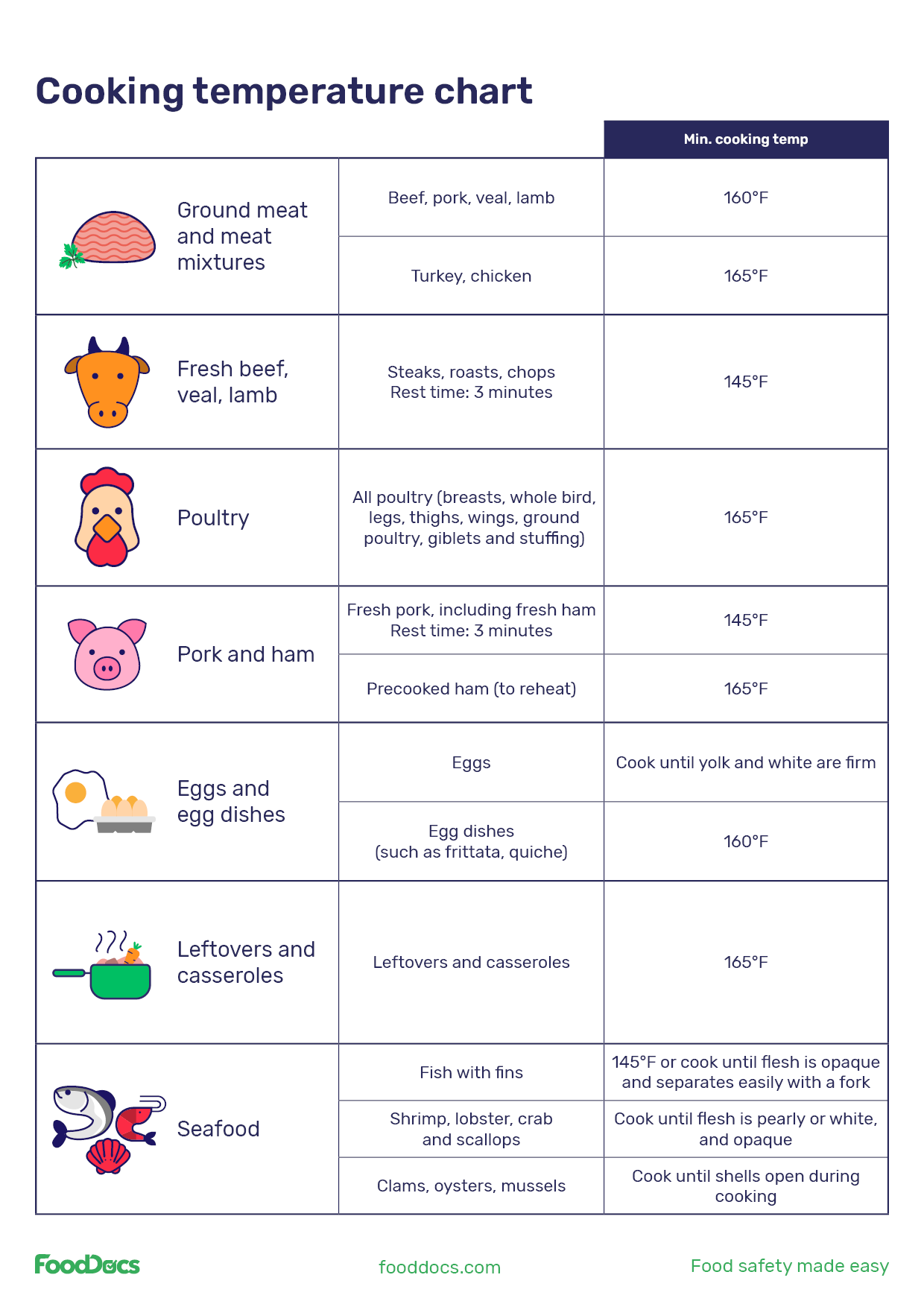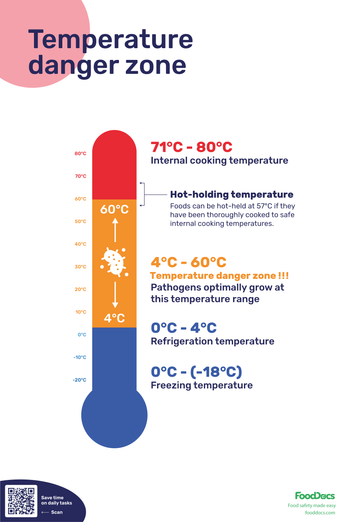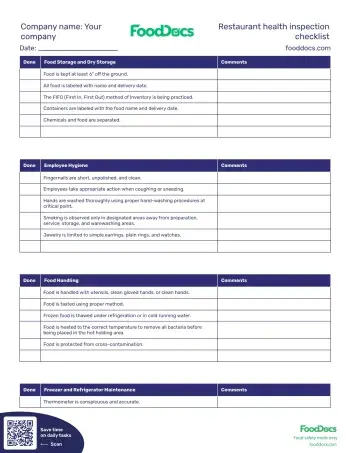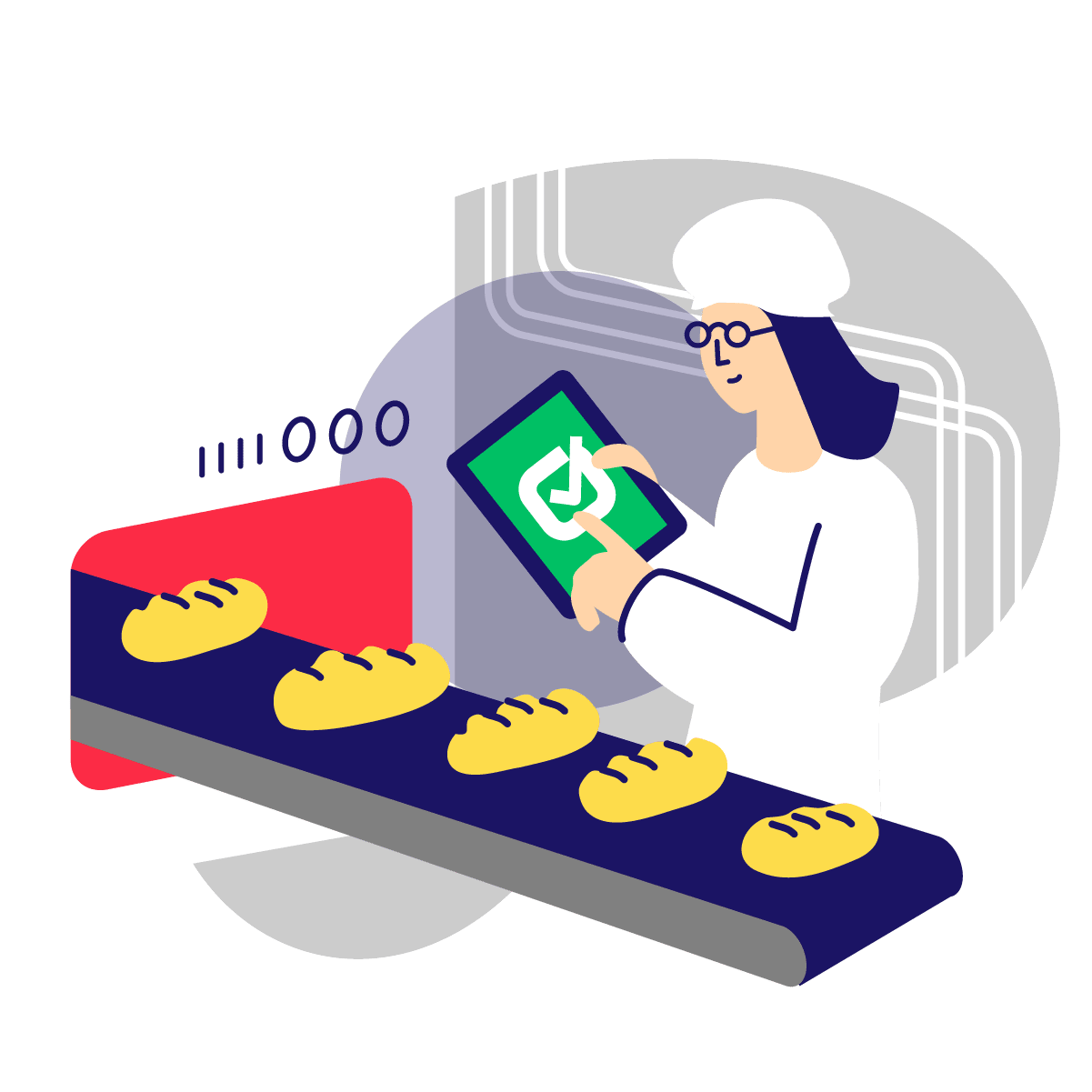All the Top Restaurant Food Safety Procedures Explained (2026 Guide)
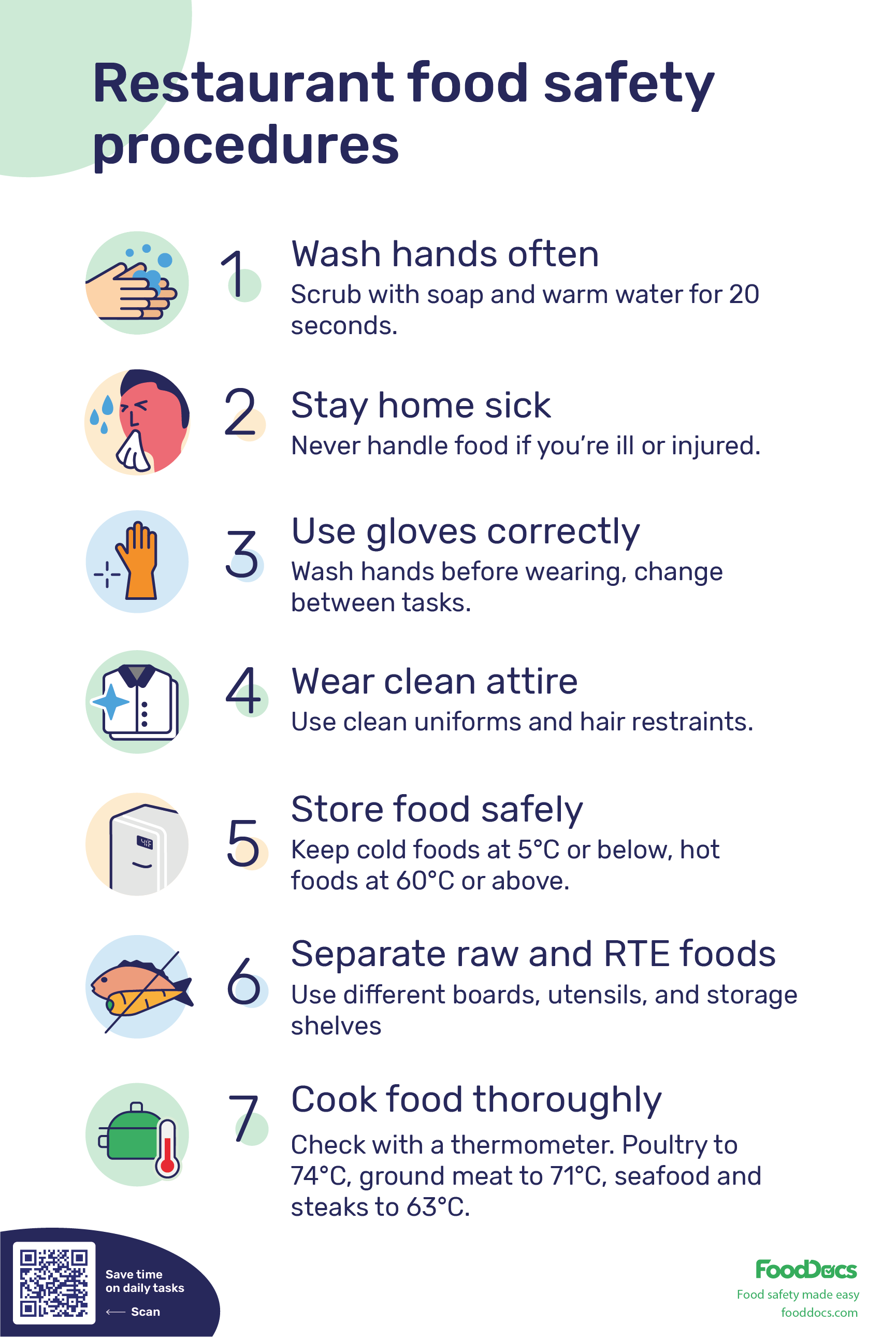



This is how our Digital Food Safety platform saves 20% of your time on daily tasks:
- Get upcoming task notifications
- Add data into the app
- Check the status of tasks in real-time

When food safety was still handled on paper, I typically spent a couple of hours per day getting the papers and going around checking or completing tasks… Now I can sit down and it's just all there in one place. It takes me 5-10 minutes.
Ruth B.
Store Manager
When you put restaurant food safety procedures into practice, hospitality leaders and their teams keep customers safe and maintain (even improve) their brand reputation.
Still, foodborne illness is a real problem. The ~48 million people in the United States who get sick every year from contaminated food back that claim up. On top of that, nearly 60% of foodborne illness outbreaks are tied to restaurants.
All it takes is one incident to harm your guests and leave your business facing bad online reviews, poor press, fines, lawsuits, or even a shutdown. The upside? If you and your team stay consistent with the right safety steps, from the moment you receive ingredients to the second meals hit the table, you can prevent most food safety issues.
To make it easier, we put together a free Restaurant Food Safety Procedures poster that sums up the key points in this guide. Print it out and hang it in the kitchen so your staff has a quick reminder every day.
Or better yet, use FoodDocs' restaurant food safety software to train your team on how to follow all the rules correctly and on time, directly in our mobile app.
This guide breaks down essential food safety procedures for restaurants into simple, practical steps you and your team can follow. Each section tackles an important question about food safety and gives you clear guidelines you can actually use.
Key takeaways
-
Handwashing with soap and warm water for 20 seconds is the single most effective way to stop germs from spreading in your kitchen.
-
Food handlers should never work while sick because illnesses like norovirus and Hepatitis A can easily be passed through food.
-
Hold cold food at 40°F or below and hold hot food at 140°F or above prevents bacteria from multiplying in the danger zone.
-
Store raw meat below ready-to-eat foods and use separate tools to stop cross-contamination.
-
Always use a food thermometer and cook poultry to 165°F, ground meat to 160°F, and seafood or steaks to 145°F.
-
Leftovers must be cooled quickly and reheated to 165°F to stay safe for guests.
-
Cleaning removes dirt, while sanitizing kills invisible germs that cause foodborne illness.
-
Labeling and rotating stock according to what’s First In, First Out reduces spoilage and food waste while keeping ingredients safe.
-
Food allergens like peanuts or shellfish must be kept separate and handled with dedicated tools to avoid cross-contact.
-
Daily logs, checklists, and risk assessments help managers catch problems early and keep food safety procedures consistent.
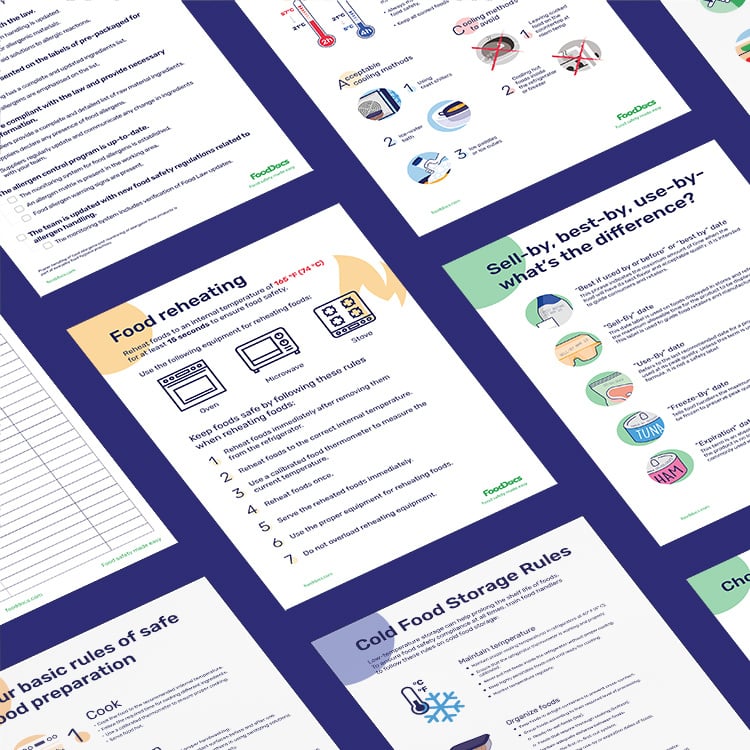
Get our most popular restaurant management resources
We can organize the most important restaurant food safety procedures into four overarching groups:
- Restaurant staff hygiene habits
- Proper food storage practices
- Cross-contamination prevention
- Safe cooking and holding temperatures
And that’s how we’ll break down each group and their sub-groups below.
How should restaurant staff practice personal hygiene?
Keeping employees healthy and clean is the first line of defense against foodborne illness. In fact, poor personal hygiene among food handlers (like not washing hands or working while sick) is a top cause of foodborne outbreaks.
Every staff member needs to uphold strict personal hygiene to avoid bringing harmful germs into the kitchen or onto customers’ plates. Here’s how:
1. Wash hands frequently and properly
Use soap and warm water to wash hands for at least 20 seconds, especially before prepping food, after handling raw ingredients, after using the restroom, or anytime hands could be contaminated.
A dedicated hand-washing sink should be used, and hands should be dried with a clean towel or disposable paper towel. Good handwashing is one of the simplest and most effective safety measures.
Get your free Restaurant Handwashing poster
2. Wear clean attire and hair restraints
Employees should come to work in clean uniforms or clothes. Anyone preparing food must tie back or cover their hair (use hairnets or caps) to prevent hair from falling into food.
Avoid jewelry like rings or bracelets during food prep, since they can harbor bacteria or fall into food. There are other important aspects of dress code for food service employees, but these are a great place to start.
3. Stay home if you’re sick or injured
Implement a strict sick leave policy. Staff with symptoms like vomiting, diarrhea, sore throat with fever, or infected cuts should not handle food until they’re better.
Viruses such as norovirus or Hepatitis A can easily spread through food if a sick worker is on duty, even if they wear gloves. It’s better to be short-staffed for a day than risk infecting customers.
4. Use gloves correctly (and change them often)
Gloves can help prevent bare-hand contact with food, but they are not a substitute for handwashing. Ensure employees wash their hands before putting on gloves and always change gloves between tasks (for example, after handling raw meat and before assembling a sandwich).
Using single-use gloves and changing them frequently prevents spreading germs from one surface or food to another.
Following these personal hygiene rules will help your team greatly reduce the chance of contaminating food. Restaurant management should train all staff on these practices and lead by example. So, if a manager stays home when ill and emphasizes handwashing, employees will understand that food safety comes first.

What are proper food storage practices?
Safe food storage keeps your ingredients fresh and prevents unnecessary bacterial growth. Once your restaurant receives food supplies, you’ve got to store them correctly to avoid spoilage or contamination. Here are key storage procedures to follow:
1. Keep foods at safe temperatures
Refrigerated food should be stored at 40°F (4°C) or below, and frozen food at 0°F (−18°C) or below. Make sure your refrigerators are set to the right temperature and use a thermometer to verify it.
Most harmful bacteria grow rapidly between 40°F and 140°F, so keeping food out of this “danger zone” is essential. Likewise, hot prepared foods that are meant to be kept warm (like in a buffet or steam table) should stay above 140°F until served.
Download your free Food Storage Chart
2. Store food off the floor in a clean area
The FDA Food Code requires storing food in a clean, dry location at least 6 inches off the floor.
Use shelves or approved storage racks that are six inches between the food and the working floor because this keeps food away from dirt, spills, and pests. Make sure storage areas are well-organized and not overcrowded, so air can circulate and you can clean easily.
3. Prevent raw meat from contaminating other foods
Always store raw meats, poultry, or seafood below ready-to-eat foods in the refrigerator. This way, meat juices can’t drip onto other items. You can use pans or containers to catch any drips as an extra precaution.
You should also keep raw and cooked foods separated in coolers and prep areas to avoid cross-contamination.
4. Label and rotate stock (FIFO)
Implement the First In, First Out method for all perishable inventory. This means mark incoming products with the date received and use the oldest items first.
Labeling containers or packages with dates help staff easily identify what needs to be used up first. This prevents older food from getting pushed to the back and spoiling. It also ensures you serve ingredients before their use-by dates, which is both safer and more cost-effective.
5. Use airtight, food-grade containers
Store open ingredients (e.g., dry goods, prepped veggies, and sauces) in clean and waterproof sealed containers. This keeps out dust, pests, and moisture.
For example, use lidded plastic bins for flour and rice, and food-grade containers with tight lids for chopped produce or leftovers. Proper containers maintain quality and prevent any external contamination.
6. Monitor suppliers and recalls
Safe storage starts with safe sourcing. Use reputable suppliers that follow food safety standards. It’s wise to stay informed about food recalls with the help of resources such as FoodSafety.gov updates or FDA recall alerts.
If an ingredient you stock is recalled due to contamination, you’ll need to pull it from your inventory immediately. Stay vigilant about recalls so you don’t accidentally serve an unsafe product.

How should we check food when receiving?
You should check food at reception by using a calibrated thermometer to verify safe temperatures, rejecting any items with swollen cans, torn packaging, broken seals, or temperatures above safe limits, and logging vendor details, items, temperatures, and any rejections.
What is date marking and how do we do it?
You should date-mark ready-to-eat food held over 24 hours by labeling it with both the prep date and the discard date, following the shortest shelf-life among ingredients, and keeping all food labels legible and consistent.
How can you prevent cross-contamination during food prep?
Cross-contamination happens when harmful germs or allergens spread from one surface or food to another. In a busy kitchen, it’s easy for bacteria from raw meat to end up on a salad, or for an allergen like peanuts to accidentally get into a dish that shouldn’t have them. Preventing cross-contamination is critical for keeping food safe. Here are the best practices:
1. Use separate equipment for raw and ready-to-eat foods
Dedicate specific cutting boards, knives, and utensils for raw meats and poultry, and others for cooked or fresh foods. For example, have one cutting board only for raw chicken and a different one for vegetables or bread.
Many kitchens use a color-coded cutting board system (e.g., red cutting board for raw meat, green for produce, and so on) so it’s easy to tell them apart. This separation avoids transferring bacteria from raw meat to foods that won’t be cooked again
Download a free Cutting Board Color Chart
2. Clean and sanitize surfaces and tools after each use
After prepping raw meat or any raw foods, thoroughly wash cutting boards, knives, countertops, and any equipment you used. Cleaning with soap and water removes visible debris, then sanitizing (with a food-safe sanitizer or hot water) kills any remaining germs.
You might wash a cutting board, for example, and then immerse it in a sanitizing solution before reusing. The same goes for cleaning and sanitizing a prep table. And don’t forget to sanitize things like meat slicers, blender jars, or any utensil that touches food. If you want to stop bacteria from spreading around the kitchen, don’t skip this step.
3. Wash hands (or change gloves) between tasks
Your hands can carry contaminants from one task to the next. So, if an employee just handled raw chicken, they must wash their hands well before chopping vegetables or plating food. Similarly, if gloves were worn, dispose of them and put on a fresh pair.
Never assume gloves alone prevent contamination. Changing them and handwashing are still necessary when switching tasks. Remind staff to avoid touching their face or hair while working, too, since that can transfer germs to food.
4. Keep allergens separate to avoid cross-contact
If your restaurant handles common allergens (e.g., peanuts, tree nuts, dairy, gluten, eggs, or any of the other 9 major allergens), have protocols to prevent those ingredients from contaminating allergen-free dishes. Use separate utensils and prep areas for allergen-free orders when possible, and clearly label allergenic ingredients in storage.
Even a small trace of an allergen can make a sensitive customer very ill, so train staff to be extra careful. For example, don’t fry french fries in the same oil used for breaded shrimp, because that could transfer shellfish allergen to the fries.
How should restaurants manage food allergens?
Food allergies affect millions of customers, and even small traces can trigger severe reactions. Every restaurant should:
- Identify which menu items contain common allergens (like peanuts, shellfish, milk, eggs, gluten, and soy)
- Clearly label allergen information on menus or recipe cards and make food allergy warning notices easily visible
- Train staff to take allergen requests seriously and avoid cross-contact (use separate utensils, prep spaces, and oil when possible)
- Have an emergency plan in place if a guest has an allergic reaction
5. Use proper containers and labels for marinating or storing raw foods
Never place cooked or ready-to-eat foods back into a container that held raw meat unless it has been cleaned and sanitized. If you marinate raw meat, don’t reuse that marinade on cooked food either, unless you boil it first to destroy bacteria.
Always cover and chill marinating foods in the fridge, not on the counter, to prevent bacterial growth. Rigorously separating raw and cooked (or ready-to-eat) items will stop germs from hitching a ride from one food to another.

Make these habits part of your kitchen’s routine. Many restaurants post reminders or use labeled equipment to help staff remember. When everyone in the kitchen is mindful of cross-contamination risks, the food you serve will be much safer for customers.
What are safe cooking and holding temperatures?
Cooking food to the proper temperature is one of the most effective ways to kill harmful bacteria. Likewise, keeping cooked food hot (or cooling it down quickly) prevents any new bacteria from growing. Every restaurant kitchen should have accurate thermometers and know the safe temperature guidelines.
Get your Internal Cooking Temperature Chart
Here’s what to do:
1. Cook foods to their recommended internal temperatures
Use a food thermometer to check doneness because you can’t rely on look or color alone.
- The USDA recommends cooking poultry (e.g., chicken and turkey) to at least 165°F (74°C) internal temperature.
- Ground meats like ground beef or sausage should reach 160°F.
- Whole cuts of beef, pork, lamb, or veal (steaks, roasts, chops) are safe at 145°F (63°C) if you let them rest for 3 minutes before serving, which allows the temperature to distribute.
- Fish and seafood should cook to 145°F as well, or until opaque.
- Eggs should be cooked until yolks and whites are firm, or to 160°F for dishes like quiche.
- Leftovers or any food that’s being reheated must reach 165°F (this ensures any bacteria that grew when cooling are destroyed).
Hitting these temperatures eliminates pathogens like Salmonella, E. coli, or Listeria that could be in the food.
2. Avoid partial cooking or “slow” cooking in the danger zone
Do not partially cook foods with the intention to finish cooking them later because bacteria can survive and multiply if the cooking process is interrupted.
You should also be cautious with methods like sous vide or smoking meats at low temps and must follow proper time-temperature guidelines to keep food safe to eat. If you’re ever in doubt, it’s safer to cook a bit longer or hotter rather than risk undercooking.
Using a calibrated thermometer for each batch of soup, each roast, or each batch of fried chicken is a great practice to verify safety.

3. Hold hot food hot (above 140°F) and cold food cold (below 40°F)
After cooking, if food is not served immediately, keep it at a safe holding temperature. Hot foods like soup or buffet items should be kept at 140°F (60°C) or higher to prevent bacterial growth.
Use equipment like steam tables, heat lamps, or slow cookers to maintain temperature, and stir regularly for even heating.
For cold foods (salads, deli plates, desserts), the rule is 40°F (4°C) or below. This might mean keeping dishes on ice or in a refrigerated unit if they’re out for a period.
Regardless of what food your restaurant serves, train staff to frequently check holding temperatures with a thermometer.
4. Don’t leave food out too long (the 2-hour rule)
Perishable foods should not sit at room temperature for more than 2 hours (or more than 1 hour if the environment is above 90°F, like an outdoor event). Once two hours are up, the risk of bacteria skyrockets.
Make it a habit that any prepared dish either gets served, chilled, or thrown out within that window. This applies to prep as well. For example, don’t leave a tray of raw chicken on the counter. Take only what you need from the fridge, then put it back.
5. Cool and refrigerate leftovers rapidly
If you have cooked food that needs to be saved and chilled, use a safe cooling method. Transfer hot food to shallow pans so it cools faster, or use an ice bath (placing a container of the hot food in ice water and stirring).
The goal is to cool foods from about 135°F down to 70°F within 2 hours, then from 70°F to 40°F within 4 more hours. This prevents bacteria from growing during cooling. Once cooled, store leftovers in the refrigerator and use them promptly, generally within 3-4 days for safety).
Never put a big pot of hot soup directly in the fridge because it won’t cool evenly and could stay in the temperature danger zone too long.
Get your Temperature Danger Zone poster
How do we calibrate food thermometers?
You should calibrate food thermometers by using ice water to confirm 32°F or boiling water to confirm 212°F, adjusting or noting any variance, and repeating the process at least weekly or any time a thermometer is dropped.
What are safe thawing methods?
You should thaw food using safe methods such as refrigeration, under cold running water, as part of the cooking process, or in a microwave followed by immediate cooking, and never thaw food on the counter.
When can time replace temperature control?
You can use time in place of temperature control for foods like sushi rice or salad bars only if you have a written procedure that begins with safe temperatures, tracks the time carefully, and discards the food on schedule.
Maintaining proper temperatures is all about guarding against the danger zone (40–140°F). Bacteria can double in number every 20 minutes in that range.
When you cook thoroughly and keep food either piping hot or nicely cold, you stop bacteria in their tracks.
As a general rule, always have a few thermometers in the kitchen and make temperature checking a routine part of cooking and holding food. It not only keeps customers safe but is also often required by health regulations.
How often should you clean and sanitize a restaurant kitchen?
Constant cleaning is part of running any kitchen. Food residue and spills can lead to bacterial growth and a dirty environment will attract pests. To prevent contamination, you need to clean and sanitize surfaces, utensils, and equipment regularly (e.g., multiple times a day.
Here’s what to focus on:
1. Clean as you go, and follow a daily cleaning schedule
Don’t wait until the end of the night to start cleaning. Good kitchens practice “clean as you go”. This involves wiping up spills immediately, washing utensils between uses, and keeping counters tidy throughout the day.
Set a schedule for thorough cleaning of all areas, including but not limited to:
- Countertops
- Cutting boards
- Sinks
- Floors
- Trash cans
- Restrooms
Many restaurants use various food safety checklists to make sure staff remember their tasks. For example, you might sanitize prep surfaces and sinks after each lunch and dinner rush, mop floors daily, and clean out refrigerators on a weekly basis.
A consistent routine keeps microbes from building up on surfaces.
2. Know the difference between cleaning and sanitizing (and do both)
Cleaning means removing visible food, dirt, or grease from surfaces with the help of soap or detergent and water. Sanitizing means treating a surface with a chemical solution or heat to kill the germs you can’t see. Both steps are necessary for food-contact surfaces.
For example, you might wash a prep table with soapy water to get off crumbs and spills, then spray or wipe it with a sanitizing solution (e.g., diluted bleach or a quaternary ammonium solution) and let it air-dry.
Equipment that’s too large to submerge (e.g., a meat slicer or a soft-serve machine) will require a knowledgeable team member or a third-party contractor to take it apart, wash, and sanitize it according to the manufacturer’s instructions.
If you use a commercial dishwasher, make sure it’s sanitizing either by hot water, with the final rinse reaching above 180°F, or the proper chemical concentration.
3. Use food-safe cleaning products and tools
Only use cleaners and sanitizers that are approved for food service and mix them at the right concentration. Common sanitizers in restaurants are chlorine-based (i.e., bleach solutions), quaternary ammonium compounds (QUATs), or iodine.
A typical bleach sanitizing solution, for example, is 1 tablespoon of unscented bleach per gallon of water, which provides ~50-100 ppm chlorine.
Remember to always follow the label directions for any sanitizer. More is not better if it leaves a harmful residue. And keep cleaning chemicals stored away from food to avoid chemical contamination.
Use of proper tools like color-coded cleaning cloths or brushes also helps prevent cross-use that can result in contamination. can prevent cross-use. For example, you might use one color for cleaning restrooms and another for kitchen surfaces to ensure their respective germs never enter other areas of the restaurant.

4. Take out trash and control pests daily
Food waste should be removed from the kitchen regularly, at least every night, to avoid attracting pests like flies or rodents. Use bins with lids and liners, and clean the trash cans often to get rid of residues and odors.
It’s also important to maintain areas around your restaurant, including dumpsters. You should always ensure these are closed and located away from back doors, with no spilled garbage that could invite pests. Check for signs of pests (e.g., droppings or chew marks) and immediately take action if you see any.
Simple steps like keeping doors closed, sealing cracks where bugs can enter, and installing air curtains or screens can keep pests out. It’s in a restaurant manager’s best interest to proactively monitor these things since many health inspectors cite “evidence of pests” as a major violation.
5. Don’t forget restrooms and customer areas
While the kitchen is the heart of food safety, unclean customer areas can also lead to problems. Restrooms should be cleaned and sanitized daily, since they can spread germs. Imagine an employee or customer using a dirty restroom and then touching dining areas or even food… Not a nice thought.
Ensure handwashing sinks in restrooms have soap, hot water, and paper towels so everyone, from staff to patrons, can wash their hands properly.
Staff should also frequently sanitize dining tables and other high-touch surfaces (e.g., door handles and menus). A clean overall restaurant environment supports food safety by minimizing places where bacteria can thrive.
What should go in a corrective action log?
You should include in a corrective action plan what went wrong, the food or unit involved, the temperature or task that was missed, the immediate fix taken, and any retraining or equipment maintenance that followed.
How should we store and use cleaning chemicals?
You should store and use cleaning chemicals by keeping them in original containers or clearly labeled bottles in a separate area away from food and equipment, mixing them according to label directions, testing concentration, and never storing them above prep surfaces.
How do we test and set sanitizer strength?
You should test and set sanitizer strength by using test strips to measure parts per million at each station, recording the results, and replacing solutions whenever they fall below target or become visibly dirty.
How do we keep ice safe for drinks and food?
You should keep ice safe for drinks and food by treating ice as food, using a clean scoop instead of glass, storing the scoop outside the bin in a clean holder, and washing and sanitizing bins and holders on a set schedule.
Very few people enjoy doing “dirty work”, so make cleaning and sanitizing a team effort and assign specific tasks to staff for each shift so it becomes routine. Using a digital daily cleaning log or sanitation checklist can help ensure each cleaning task is done safely and checked off quickly.
So, what are the most common restaurant food safety procedures?
In summary:
- Wash hands often with soap and warm water for at least 20 seconds
- Stay home if sick and use gloves correctly
- Store food at safe temperatures (below 40°F cold, above 140°F hot)
- Keep raw meat separate from ready-to-eat foods
- Cook foods to safe internal temperatures (e.g., chicken to 165°F)
- Cool and reheat foods properly to avoid the danger zone
- Clean and sanitize surfaces, utensils, and equipment regularly
- Follow a daily cleaning schedule and control pests
- Label and rotate stock using FIFO
- Use daily logs and checklists to monitor food safety tasks
Next, let’s move into restaurant food safety topics that will complement what you’ve learned so far.
What is a restaurant health and safety risk assessment?
A restaurant risk assessment is a proactive way to spot hazards before they cause problems. For food safety, this means:
- Walking through the kitchen and dining areas to check for risks (e.g., improper storage or broken equipment)
- Reviewing food handling steps to identify where contamination could occur
- Prioritizing the highest-risk issues (e.g., a fridge not holding temperature)
- Documenting the risks and the actions you’ll take to fix them
Regular risk assessments help managers stay ahead of problems and keep both staff and guests safe.
What records should we have ready for inspectors?
You should have records ready for inspectors that include temperature logs, cooling logs, cleaning and sanitizer checks, pest control records, training records, calibration logs, corrective action reports, and any allergen or time-as-control procedures.
How do we handle a foodborne illness complaint?
You should handle a foodborne illness complaint by listening carefully, documenting visit details and foods eaten, pulling related logs, isolating suspect food, notifying the health department if required, and reviewing procedures to prevent recurrence.
How should we manage delivery and takeout safety?
You should manage delivery and takeout safety by using tamper-evident packaging, labeling allergens and reheat instructions, holding hot food above 140 °F and cold food below 40 °F before handoff, and verifying delivery times to keep food out of the danger zone.
What should a weekly self-inspection include?
You should include in a weekly self-inspection checks for safe temperatures, proper labeling, correct storage order, sanitizer strength, handwashing supplies, and pest activity, and then assign fixes with due dates and verify completion.
How do we manage shellfish tags and traceability?
You should manage shellfish tags and traceability by keeping tags linked to each batch, retaining them for the required time after the last item is served, storing them in order, and noting the final serve date for trace-back.
What equipment maintenance matters for safety?
You should manage kitchen equipment maintenance for safety by checking fridge gaskets, thermometer probe batteries, dish machine rinse temperatures or chemical levels, and hood filters, and scheduling repairs whenever readings drift or cleaning is overdue.
How do we prepare for a power outage?
You should prepare for a power outage by keeping fridge and freezer doors closed, tracking times, probing food temperatures when power returns, and discarding food that rises above safe limits beyond the allowed timeframe.
How can you monitor and maintain food safety daily?
Having great procedures on paper is one thing, but consistent execution is what keeps a kitchen truly safe. Monitoring means checking that tasks are done correctly every day and keeping records of your efforts, while maintaining means continuously improving and staying up-to-date with standards.
This involves training your team, logging critical information, and regularly reviewing your food safety practices. Consider these steps:
1. Keep SOPs, daily logs, and checklists
Documentation might sound tedious, but it’s extremely important. Standard operating procedures (e.g., a sanitation SOP) are foundational to team training and empower staff to use logs to record things like refrigerator temperatures, cooking temperatures, cleaning schedules and any incidents (like if you had to throw out food because a cooler failed), correctly.
Many food safety regulations require monitoring logs, and they prove that you are consistently following procedures. For example, keep a temperature log by each fridge where staff write down the temperature once per shift; and use a deep cleaning checklist for opening and closing duties.
These records act as a “snapshot” of your kitchen’s safety practices and help identify any trends or issues. If a health inspector walks in, your ability to quickly, easily, and confidently show a complete history of logs will show them that you’re on top of food safety.
2. Train and remind your staff regularly
Even well-trained employees can forget things over time, especially with high turnover in the restaurant food service industry. Make food safety training part of your onboarding for new hires, covering all the topics we’ve discussed:
- Staff hygiene
- Cross-contamination
- Food safety temperatures
- Cleaning and sanitation
It can be worthwhile to have restaurant employees attain a food handler certification (e.g., ServSafe) so they understand the “why” behind the rules.
Beyond initial training, provide refreshers every 3-6 months. This could look like brief team huddles or reminders about seasonal issues (e.g., extra handwashing reminders during flu season, or grilling safety at a summer event). A simple food safety quiz is a great resource to keep on hand to support that refresh.
When staff understand the importance of each task — the why — and feel responsible for it, you build a strong food safety culture.
3. Do self-inspections and fix problems promptly
Don’t wait for the official safety and health inspection to find out if something’s wrong. Every so often, walk through your restaurant as if you’re the inspector. Check if thermometers are accurate, if food is labeled, if there’s any cross-contamination risk in storage, if sanitizer buckets are set up, and anything else that’d be on a restaurant safety audit checklist.
Get your free Health Inspection Checklist
You can use a comprehensive checklist that covers all areas of food handling, storage, cleaning, and hygiene to audit yourself. Doing this monthly or quarterly will help you spot and correct issues early, whether it’s retraining an employee on glove use or repairing a fridge that’s running warm.
Encourage your team to speak up and report any hazards they notice as well. Proactive internal audits will keep you ready for the real inspection and ensure continuous compliance.
4. Stay informed on food safety updates
Food safety guidelines and regulations can change, and new best practices emerge, especially as we learn from outbreaks or new research. Keep an eye on updates from your local health department, the FDA or USDA, and restaurant industry news.
This could mean subscribing to email alerts, attending an annual seminar, or simply checking reputable websites. For example, rules around allergens or time-temperature controls can be updated, and you’d want to adapt your procedures accordingly.
Being informed also includes tracking food recalls (as mentioned earlier) and having a plan for what to do if a product you use is recalled. Overall, make learning part of your restaurant’s food safety program.
5. Foster a kitchen culture where food safety is everyone’s job
When line cooks, servers, managers, and even dishwashers all understand the importance of these procedures, they are more likely to follow them diligently. Praise team members for good food safety habits you observe. Make it clear that you value safety even on busy nights.
For example, it’s better to delay a dish to finish cooking it properly than to rush it out undercooked. If mistakes happen (e.g., someone forgetting to log a temperature or skipped a cleaning), constructively address them and use it as a teaching moment. Over time, a strong food safety culture leads to automatic good habits in the restaurant.
Maintaining high food safety standards in a restaurant is definitely a lot of work, but it’s work that protects your customers, your business, and your peace of mind.
Following the procedures outlined above — from personal hygiene and safe storage to proper cooking, cleaning, and monitoring — you can significantly reduce the risk of foodborne illness. These steps eventually become second nature for a well-trained team.
How can restaurant food safety software make following procedures so much easier?
Using restaurant food safety software like FoodDocs can streamline your daily monitoring tasks, reduce time spent on completing those tasks, and remove the risk that comes with paper-based food safety. Try it free for 14 days, no credit card required.
You can add visual step-by-step instructions to train on-the-go so that staff are able to complete tasks correctly and consistently.

The mobile app also sends smart notifications with the food safety tasks each staff is responsible for, so they never miss a task.
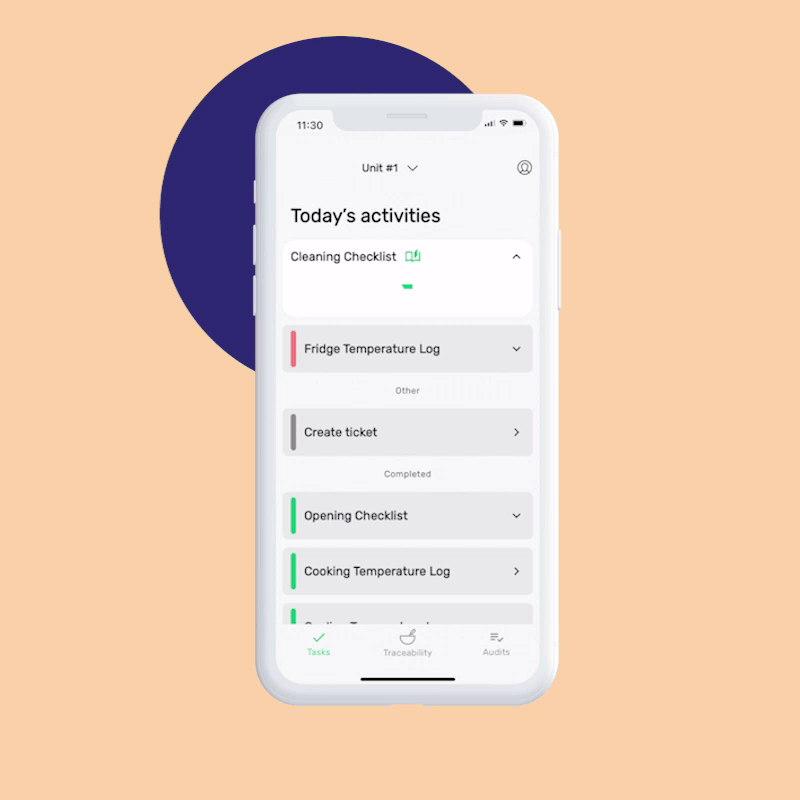
FoodDocs' digital food safety management system allows you to quickly and easily set up checklists and logs for everything from temperature checks to cleaning schedules in minutes.
Managers also get a real-time dashboard that shows which tasks are done and if anything was skipped, providing a high-level view of your operation’s food safety status.
This kind of system has proven to save FoodDocs customers up to 2+ hours daily and helps ensure nothing falls through the cracks.
While you can certainly use pen-and-paper logs, a digital solution can be more efficient and is easy to update as your procedures change.
Frequently asked questions about restaurant food safety procedures
Which agency enforces food safety in a restaurant?
Food safety in a restaurant is enforced by your local health department, which follows federal guidance from the FDA Food Code and, in some cases, USDA regulations. Inspectors from these agencies visit restaurants to check compliance with sanitation, storage, cooking, and employee hygiene rules.
Who is responsible for food safety in a restaurant?
Food safety in a restaurant is the responsibility of every staff member, from line cooks to servers, but managers and owners carry the ultimate responsibility for training, oversight, and compliance. When everyone understands their role, procedures are more consistently followed.
What food safety guidelines should be followed regarding leftovers from a restaurant?
The food safety guidelines for leftovers from a restaurant are to cool food quickly, store it at 40°F or below, reheat to 165°F before serving, and discard after 3–4 days. Large batches should be cooled in shallow pans or an ice bath to prevent time in the danger zone.
What are some of the common challenges to food safety in a restaurant or foodservice operation?
Some of the common challenges to food safety in a restaurant or foodservice operation include high staff turnover, inconsistent training, equipment failures, and the fast pace of service. These factors can lead to skipped steps or missed logs, which makes a strong food safety culture and regular monitoring critical.
